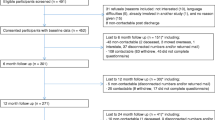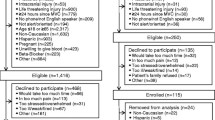Abstract
Soft tissue injuries (STI) arising from motor vehicle accidents (MVA) are significant cause of chronic pain, disability, and cost in patients. This study compares demographics and outcomes of MVA and non-MVA patients attending a community-based interdisciplinary pain management program funded by the Ontario Ministry of Health. This descriptive, cross-sectional practice-based retrospective study was conducted on 121 consecutive patients, screened for motivation and commitment, and admitted to an intense 3-month pain management program during 2016–2018 (MVA n = 31 and non-MVA n = 90). Data collected included: (a) demographics; (b) pain characteristics; (c) physical and emotional health status obtained by validated instruments, and (d) social outcomes regarding work or school obtained via retrospective chart review. Means of pre- and post-program variables (baseline and upon program exit) were compared to assess effectiveness of treatment in both groups. At baseline, the MVA group was more likely to have a lawyer; included more women; had shorter duration of pain complaints; and higher scores in Kinesiophobia (TSK), anxiety (GAD) and depression (CES-D). Upon program exit, MVA patients had improved by 29–60% and non-MVA patients by 32–57% in pain catastrophizing, self-efficacy, pain interference and severity scores, kinesiophobia, anxiety and depression, while both groups improved substantially in their social health status 6 and/or 12 months after program exit. Despite the presence of litigation, well-selected MVA patients attending a community-based interdisciplinary pain management program can obtain substantial improvement across several domains, almost equal to that obtained by non-MVA patients with chronic pain.


Similar content being viewed by others
Availability of data and material
Data not available because patients’ participants’ information, privacy, and confidentiality could be compromised.
Code Availability
Not Applicable.
References
American Pain Society White Paper: Interdisciplinary Pain Management. (2008).
Ameratunga, S. N., Norton, R. N., Bennett, D. A., & Jackson, R. T. (2004). Risk of disability due to car crashes: A review of the literature and methodological issues. Injury, 35(11), 1116–1127.
Angst, F., Verra, M. L., Lehmann, S., Brioschi, R., & Aeschlimann, A. (2009). Clinical effectiveness of an interdisciplinary pain management programme compared with standard inpatient rehabilitation in chronic pain: A naturalistic, prospective controlled cohort study. Journal of Rehabilitation Medicine, 41(7), 569–575.
Barnsley, L., Lord, S., & Bogduk, N. (1994). Whiplash injury. Pain, 58(3), 283-307.
Bosy, D., Etlin, D., Corey, D., & Lee, J. W. (2010). An interdisciplinary pain rehabilitation programme: Description and evaluation of outcomes. Physiotherapy Canada, 62(4), 316–326.
Canadian Association of Chiefs of Police Canada. (2020). Road Safety Week 2020–National Facts And Stats May 12–18, 2020 https://www.cacp.ca/index.html?asst_id=2143 Accessed 04 JULY 2021.
Carroll, L. J., Holm, L. W., Hogg-Johnson, S., Côté, P., Cassidy, J. D., Haldeman, S., & Guzman, J. (2009). Course and prognostic factors for neck pain in whiplash-associated disorders (WAD): Results of the bone and joint decade 2000–2010 task force on neck pain and its associated disorders. Journal of Manipulative and Physiological Therapeutics, 32(2), S97–S107.
Cheatle, M. D. (2016). Biopsychosocial approach to assessing and managing patients with chronic pain. Medical Clinics, 100(1), 43–53.
Cleeland, C. S., & Ryan, K. M. (1994). Pain assessment: Global use of the Brief Pain Inventory. Annals, Academy of Medicine, Singapore.
Engel, G. L. (1977). The need for a new medical model: A challenge for biomedicine. Science, 196(4286), 129–136.
Finestone, H. M., Alfeeli, A., & Fisher, W. A. (2008). Stress-induced physiologic changes as a basis for the biopsychosocial model of chronic musculoskeletal pain: A new theory? The Clinical Journal of Pain, 24(9), 767–775.
Gatchel, R. J., McGeary, D. D., McGeary, C. A., & Lippe, B. (2014). Interdisciplinary chronic pain management: Past, present, and future. American Psychologist, 69(2), 119.
Geisser, M. E., Roth, R. S., & Robinson, M. E. (1997). Assessing depression among persons with chronic pain using the Center for Epidemiological Studies-Depression Scale and the Beck Depression Inventory: A comparative analysis. The Clinical Journal of Pain, 13(2), 163–170.
Giummarra, M. J., Ioannou, L., Ponsford, J., Cameron, P. A., Jennings, P. A., Gibson, S. J., & Georgiou-Karistianis, N. (2016). Chronic pain following motor vehicle collision. A systematic review of outcomes associated with seeking or receiving compensation. The Clinical Journal of Pain, 32(9), 817–827.
Gurumoorthy, D., & Twomey, L. (1996). The Quebec Task Force on Whiplash-Associated Disorders. Spine, 21(7), 897–898.
Guzmán, J., Esmail, R., Karjalainen, K., Malmivaara, A., Irvin, E., & Bombardier, C. (2001). Multidisciplinary rehabilitation for chronic low back pain: Systematic review. Bmjj, 322(7301), 1511–1516.
Harder, S., Veilleux, M., & Suissa, S. (1998). The effect of socio-demographic and crash-related factors on the prognosis of whiplash. Journal of Clinical Epidemiology, 51(5), 377–384.
Herrström, P., Lannerbro-geijer, G., & Högstedt, B. (2000). Whiplash injuries from car accidents in a Swedish middle-sized town during 1993–95. Scandinavian Journal of Primary Health Care, 18(3), 154–158.
Katz, L., Patterson, L., & Zacharias, R. (2019). Evaluation of an interdisciplinary chronic pain program and predictors of readiness for change. Canadian Journal of Pain, 3(1), 70–78.
Korri, S. H., Miller, R. P., & Todd, D. D. (1990). Kinesiophobia: A new view of chronic pain behaviour. Pain Manag, 3, 35–43.
Kroenke, K., Spitzer, R. L., & Williams, J. B. (2001). The PHQ-9: Validity of a brief depression severity measure. Journal of General Internal Medicine, 16(9), 606–613.
Littleton, S. M., Cameron, I. D., Poustie, S. J., Hughes, D. C., Robinson, B. J., Neeman, T. E., & Smith, P. N. (2011). The association of compensation on longer-term health status for people with musculoskeletal injuries following road traffic crashes: Emergency department inception cohort study. Injury, 42(9), 927–933.
Lankester, B. J. A., Garneti, N., & Bannister, G. C. (2004). The classification of outcome following whiplash injury—A comparison of methods. European Spine Journal, 13(7), 605–609.
Mailis, A., & Lakha, S. F. (2019). From (Ontario Ministry of Health and Long-Term Care) policy to implementation: A retrospective look at a community-based patient-centered model of care for chronic pain. Canadian Journal of Pain, 3(1), 114–125.
Nicholas, M. K. (2007). The pain self-efficacy questionnaire: Taking pain into account. European Journal of Pain, 11(2), 153–163.
Ontario Health Claims Database HCDB Standard Report – 2018-H1 / (September 2018) http://assets.ibc.ca/Documents/Auto%20Insurance/facts/HCDB-Standard-Report-2018H2.pdf Accessed July 04, 2021.
Oslund, S., Robinson, R. C., Clark, T. C., Garofalo, J. P., Behnk, P., Walker, B., ... & Noe, C. E. (2009, July). Long-term effectiveness of a comprehensive pain management program: Strengthening the case for interdisciplinary care. In Baylor University Medical Center Proceedings (Vol. 22, No. 3, pp. 211–214). Taylor & Francis.
Quinlan, K. P., Annest, J. L., Myers, B., Ryan, G., & Hill, H. (2004). Neck strains and sprains among motor vehicle occupants—United States, 2000. Accident Analysis & Prevention, 36(1), 21–27.
Samoborec, S., Ruseckaite, R., Ayton, D., & Evans, S. (2018). Biopsychosocial factors associated with non-recovery after a minor transport-related injury: A systematic review. PLoS One, 13(6), e0198352.
Schatman, M. E. (2012). Interdisciplinary chronic pain management: International perspectives. Pain: Clinical Updates, 20(7), 1–5.
Spitzer, W. O. (1995). Scientific monograph of the Quebec Task Force on Whiplash-Associated Disorders: Redefining “whiplash” and its management. Spine, 20, 1S-73S.
Spitzer, R. L., Kroenke, K., Williams, J. B., & Löwe, B. (2006). A brief measure for assessing generalized anxiety disorder: The GAD-7. Archives of Internal Medicine, 166(10), 1092–1097.
Stanos, S. (2012). Focused review of interdisciplinary pain rehabilitation programs for chronic pain management. Current Pain and Headache Reports, 16(2), 147–152.
Sullivan, M. J., Bishop, S. R., & Pivik, J. (1995). The pain catastrophizing scale: Development and validation. Psychological Assessment, 7(4), 524.
Styrke, J., Stålnacke, B. M., Bylund, P. O., Sojka, P., & Björnstig, U. (2012). A 10-year incidence of acute whiplash injuries after road traffic crashes in a defined population in northern Sweden. PM&R, 4(10), 739–747.
Svestkova, O. (2008). International classification of functioning, disability and health of World Health Organization (ICF). Prague Medical Report, 109(4), 268–274.
Turk, D. C., Dworkin, R. H., Allen, R. R., Bellamy, N., Brandenburg, N., Carr, D. B., & Witter, J. (2003). Core outcome domains for chronic pain clinical trials: IMMPACT recommendations. Pain, 106(3), 337–345.
Wismans, K. S. H. M., & Huijkens, C. G. (1994). Incidentie en prevalentie van het ‘whiplash’-trauma. TNO report, 94.
World Health Organization. World report on disability 2011. https://www.who.int/disabilities/world_report/2011/report.pdf?ua=1 Accessed July 04, 2021.
World Health Organization (WHO): ICF – International Classification of Functioning, Disability and Health. Geneva: World Health Organization; 2001, p. 10–20.
Author information
Authors and Affiliations
Contributions
All authors discussed the consequences and implications and commented on the manuscript at all stages. All authors have approved the manuscript, and agree with its submission to Psychology and Injury Law.
Corresponding author
Ethics declarations
Ethics approval and consent to participate
The study was reviewed and approved by the University of Toronto Human Ethics Research Committee (Protocol ##36,903). Statement included in the method section. All patients had freely given informed consent to participate in the study. Informed consent statement included in the method section.
Consent for publication
Written informed consent for publication of their clinical details was obtained from the patients.
Conflict of interest
The authors declare no competing interests.
Additional information
Publisher's Note
Springer Nature remains neutral with regard to jurisdictional claims in published maps and institutional affiliations.
Rights and permissions
About this article
Cite this article
Lakha, S.F., Hapidou, E.G., Robinson, J. et al. Comparison of Motor Vehicle Accident (MVA) Survivors and Non-MVA Pain Patients Attending an Interdisciplinary Pain Management Program. Psychol. Inj. and Law 15, 385–394 (2022). https://doi.org/10.1007/s12207-021-09440-y
Received:
Accepted:
Published:
Issue Date:
DOI: https://doi.org/10.1007/s12207-021-09440-y




